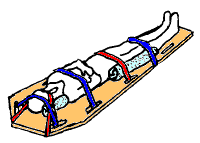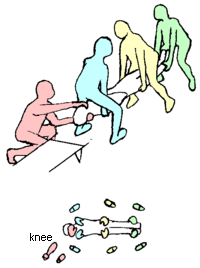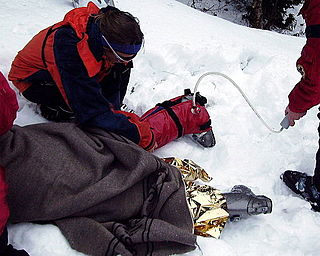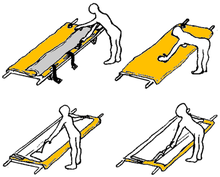
A stretcher, gurney, litter, or pram is an apparatus used for moving patients who require medical care. A basic type must be carried by two or more people. A wheeled stretcher is often equipped with variable height frames, wheels, tracks, or skids.

A spinal board, is a patient handling device used primarily in pre-hospital trauma care. It is designed to provide rigid support during movement of a person with suspected spinal or limb injuries. They are most commonly used by ambulance staff, as well as lifeguards and ski patrollers. Historically, backboards were also used in an attempt to "improve the posture" of young people, especially girls.
Casualty movement is the collective term for the techniques used to move a casualty from the initial location to the ambulance.

Casualty lifting is the first step of casualty movement, an early aspect of emergency medical care. It is the procedure used to put the casualty on a stretcher.

Vehicle extrication is the process of removing a vehicle from around a person who has been involved in a motor vehicle collision, when conventional means of exit are impossible or inadvisable. A delicate approach is needed to minimize injury to the victim during the extrication. This operation is usually accomplished by using chocks and bracing for stabilization and powered rescue tools and equipment, including the Jaws of Life. Standards and regulations for organizations can be found in NFPA 1670 and for individual members in 1006.

A cervical collar, also known as a neck brace, is a medical device used to support and immobilize a person's neck. It is also applied by emergency personnel to those who have had traumatic head or neck injuries, and can be used to treat chronic medical conditions.

A Kendrick extrication device (KED) is a device used in extrication of victims of traffic collisions from motor vehicles. Commonly carried on ambulances, a KED is typically used by an emergency medical technician, paramedic, or another first responder. It was originally designed for extrication of race car drivers. Typically used in conjunction with a cervical collar, a KED is a semi-rigid brace that secures the head, neck and torso in an anatomically neutral position. Its use is claimed to reduce the possibility of additional injuries to these regions during extrication, although its value has been questioned, as there is a lack of evidence to support its use. The original KED was designed by Richard Kendrick in 1978.

The scoop stretcher is a device used specifically for moving injured people. It is ideal for carrying casualties with possible spinal injuries.

A cervical fracture, commonly called a broken neck, is a fracture of any of the seven cervical vertebrae in the neck. Examples of common causes in humans are traffic collisions and diving into shallow water. Abnormal movement of neck bones or pieces of bone can cause a spinal cord injury, resulting in loss of sensation, paralysis, or usually death soon thereafter, primarily via compromising neurological supply to the respiratory muscles as well as innervation to the heart.
Outdoor emergency care (OEC) was first developed by the National Ski Patrol in the 1980s for certification in first aid, and other pre-hospital care and treatment for possible injuries in non-urban settings. Outdoor emergency care technicians provide care at ski resorts, wilderness settings, white-water excursions, mountain bike events, and in many other outdoor environments.
A traction splint most commonly refers to a splinting device that uses straps attaching over the pelvis or hip as an anchor, a metal rod(s) to mimic normal bone stability and limb length, and a mechanical device to apply traction to the limb.
Stabilization is a process to help prevent a sick or injured person from having their medical condition deteriorate further too quickly before they can be treated in depth at a medical facility.

A vacuum splint is a device like a small vacuum mattress that is used in emergency medicine as a temporary splint. Vacuum splints operate by extracting air from the splint itself to enable the thousands of polystyrene balls inside the splint to mold around the injured body part similar to an orthopedic cast. Vacuum splints are primarily used by paramedics to splint trauma-related injuries, joint dislocation, subluxation, and extremity fractures.

Australian mobile intensive care ambulances (MICA) are well-equipped ambulances staffed by highly trained paramedics dispatched to emergency situations where patients require a higher level of care than a regular ambulance can provide.
Grady straps are a specific strapping configuration used in full body spinal immobilization.

Combat medics of the United States military may put themselves at greater risk than many other roles on the battlefield. In recent conflicts, the enemies faced by a professional army may not have respect for the laws of war and may actively target combat medics for the significant value they have in keeping the unit combat-effective. Since the non-combatant status granted to medics may not always be respected, modern combat medics carry weapons for personal defense and in most Western armies are virtually indistinguishable from regular infantrymen.
Vacuum bag moulding is the primary composite manufacturing process for producing laminated structures. It is common in the aerospace industry.

A hospital bed or hospital cot is a bed specially designed for hospitalized patients or others in need of some form of health care. These beds have special features both for the comfort and well-being of the patient and for the convenience of health care workers. Common features include adjustable height for the entire bed, the head, and the feet, adjustable side rails, and electronic buttons to operate both the bed and other nearby electronic devices.

Spinal precautions, also known as spinal immobilization and spinal motion restriction, are efforts to prevent movement of the spine in those with a risk of a spine injury. This is done as an effort to prevent injury to the spinal cord. It is estimated that 2% of people with blunt trauma will have a spine injury.

Neil Robertson stretcher (NRS) is a type of rescue stretcher designed for the purpose of safely transferring an injured person by either lowering or lifting them to a place of safety. It is constructed from wooden slats and canvas. It features the patient being wrapped in canvas and secured using robust canvas straps, with a lifting rope affixed to a head-mounted ring and a guideline tied near the ankles, serving to halt the stretcher's movement. It has been utilized by the Royal Navy for nearly a century. The Neil Robertson stretcher has been widely adopted in Australia and other countries, and has been credited with reducing the risk of further injury to patients during transport.
















